The smart school bus platform market is forecast to expand from USD 410.0 million in 2025 to USD 997.6 million by 2035, growing 2.43X at a CAGR of 9.3%. The market’s acceleration is driven by digitization in student transportation, demand for real-time tracking, and enhanced communication among parents, schools, and transport operators. By deployment model, the cloud-based segment, accounting for a 65% share in 2025, dominates due to its scalability, remote accessibility, and superior multi-stakeholder functionality. School districts and contractors prefer cloud-native systems for seamless access, centralized monitoring, and integration with mobile and GPS platforms. This architecture is also favored for its cost-effectiveness, cybersecurity compliance, and interoperability across regional education systems, ensuring higher uptime and reliability in student safety operations.
By application, the K12 schools segment leads with 75% market share, driving platform adoption. Elementary and secondary education institutions represent the largest user base, with administrators prioritizing technology that combines student safety monitoring, route optimization, and compliance documentation. The segment’s strength stems from expanding school enrollment, government safety mandates, and parental expectations for transparency and communication. IoT connectivity and smartphone integration are reshaping K12 transportation, offering real-time alerts, attendance verification, and driver behavior analytics. Special education applications are also gaining traction due to the need for precise routing, secure entry verification, and customized communication with caregivers.
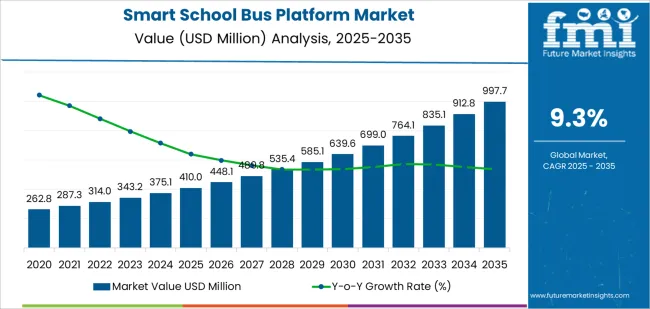
From 2030 to 2035, the market is forecast to grow from USD 639.5 million to USD 997.6 million, adding another USD 358.1 million, which constitutes 61.0% of the overall ten-year expansion. This period is expected to be characterized by the integration of artificial intelligence for predictive analytics, the expansion of video surveillance and driver monitoring systems, and the growth of cloud-based platforms enabling comprehensive fleet management capabilities. The growing adoption of smart city initiatives and connected vehicle technologies will drive demand for school bus platforms with enhanced data analytics and automated safety features.
Between 2020 and 2025, the smart school bus platform market experienced steady growth, driven by increasing regulatory requirements for student transportation safety and growing recognition of digital platforms as essential infrastructure for modern school transportation operations. The market developed as school administrators and transportation managers recognized the potential for smart platform technology to enhance route efficiency, improve student safety monitoring, and support communication objectives while meeting compliance requirements. Technological advancement in IoT connectivity and mobile applications began emphasizing the critical importance of maintaining real-time visibility and communication capabilities in student transportation environments.
| Metric | Value |
|---|---|
| Estimated Value in (2025E) | USD 410.0 million |
| Forecast Value in (2035F) | USD 997.6 million |
| Forecast CAGR (2025 to 2035) | 9.3% |
Market expansion is being supported by the increasing global demand for student transportation safety driven by parental concerns and regulatory requirements, alongside the corresponding need for intelligent monitoring systems that can enhance route efficiency, enable real-time tracking capabilities, and maintain operational transparency across school districts, private education institutions, and contracted transportation services. Modern school administrators and transportation managers are increasingly focused on implementing platform solutions that can improve student safety, enhance operational efficiency, and provide consistent communication in demanding transportation conditions.
The growing emphasis on connected infrastructure and smart city integration is driving demand for school bus platforms that can support data-driven decision making, enable predictive maintenance capabilities, and ensure comprehensive safety compliance. School districts' preference for digital solutions that combine safety enhancement with operational efficiency and communication effectiveness is creating opportunities for innovative platform implementations. The rising influence of IoT adoption and mobile connectivity is also contributing to increased adoption of platforms that can provide superior monitoring capabilities without compromising data security or operational reliability.
The market is segmented by deployment model, application, and region. By deployment model, the market is divided into cloud-based, local-based, and others. Based on application, the market is categorized into K12 schools, special education, and others. Regionally, the market is divided into East Asia, Europe, North America, South Asia, Latin America, Middle East & Africa, and Eastern Europe.
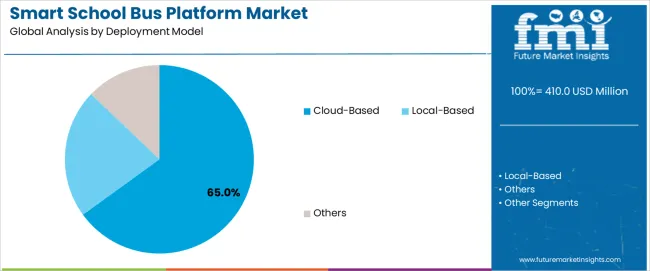
The cloud-based segment is projected to maintain its leading position in the smart school bus platform market in 2025, with an estimated market share of 65%, reaffirming its role as the preferred deployment architecture for real-time tracking and data management applications. School districts and transportation service providers increasingly utilize cloud-based platforms for their superior scalability, remote accessibility characteristics, and proven effectiveness in enabling multi-stakeholder access while maintaining data security and system reliability. Cloud-based platform technology's proven effectiveness and deployment versatility directly address the industry requirements for cost-effective implementation and flexible access across diverse user groups and geographic locations.
This deployment model forms the foundation of modern school transportation management infrastructure, as it represents the architecture with the greatest contribution to system accessibility and established performance record across multiple school district configurations and operational scenarios. Education sector investments in digital transformation continue to strengthen adoption among school administrators and transportation managers. With operational pressures requiring improved parent communication and real-time visibility, cloud-based platforms align with both efficiency objectives and accessibility requirements, making them the central component of comprehensive student transportation safety strategies.
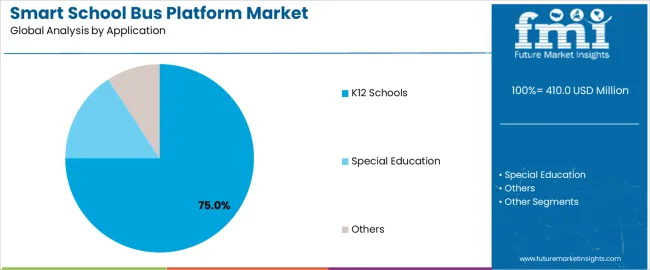
The K12 schools application segment is projected to represent the largest share of smart school bus platform demand in 2025, with an estimated 75% share, underscoring its critical role as the primary driver for platform adoption across elementary schools, middle schools, and high schools serving mainstream student populations. School administrators prefer smart platforms for student transportation due to their exceptional monitoring capabilities, communication effectiveness, and ability to balance safety requirements with operational efficiency while supporting regulatory compliance and parental engagement. Positioned as essential technology for modern student transportation operations, smart platforms offer both safety advantages and operational benefits.
The segment is supported by continuous expansion in school enrollment and the growing availability of affordable IoT devices that enable superior transportation management with enhanced visibility and reduced administrative burden. School districts are investing in comprehensive platform implementation programs to support increasingly demanding parent expectations and regulatory requirements for student safety documentation. As education digitization accelerates and safety standards increase, the K12 schools application will continue to dominate the market while supporting advanced monitoring capabilities and parent communication optimization strategies.
The smart school bus platform market is advancing steadily due to increasing demand for student safety solutions driven by regulatory requirements and growing adoption of connected vehicle technologies that require specialized monitoring platforms providing enhanced tracking capabilities and communication benefits across school districts, private education facilities, and transportation contractor operations. The market faces challenges, including high implementation costs and infrastructure investment requirements, data privacy concerns and cybersecurity vulnerabilities, and integration constraints related to legacy vehicle fleets and fragmented technology ecosystems. Innovation in artificial intelligence integration and edge computing capabilities continues to influence product development and market expansion patterns.
The growing adoption of artificial intelligence technologies is driving demand for specialized platform capabilities that address advanced operational requirements including predictive maintenance alerts, driver behavior analysis, and route optimization through machine learning algorithms. AI-powered school bus platforms require advanced data processing capabilities that deliver superior insights across multiple operational parameters while maintaining system responsiveness and cost-effectiveness. Transportation managers are increasingly recognizing the competitive advantages of AI integration for safety enhancement and operational efficiency, creating opportunities for innovative platform features specifically designed for next-generation student transportation management.
Modern smart school bus platforms are incorporating comprehensive video surveillance and driver monitoring technologies to enhance student safety, improve incident documentation, and support driver training objectives through real-time behavioral analysis and automated alert systems. Leading platform providers are developing integrated camera systems, implementing AI-powered monitoring capabilities, and advancing technologies that enable automated incident detection and driver coaching. These technologies improve safety performance while enabling new operational capabilities, including proactive intervention, behavior-based training, and comprehensive incident investigation. Advanced video integration also allows transportation managers to support comprehensive compliance objectives and operational transparency beyond traditional GPS tracking attributes.
The expansion of stakeholder communication requirements, mobile device proliferation, and parent engagement expectations is driving demand for cloud-native platforms with seamless multi-user access and real-time notification capabilities. These advanced applications require specialized platform architectures with intuitive user interfaces that exceed traditional fleet management requirements, creating premium market segments with differentiated value propositions. Developers are investing in mobile application development and user experience optimization to serve emerging communication requirements while supporting innovation in parent engagement, administrative oversight, and transportation contractor coordination.
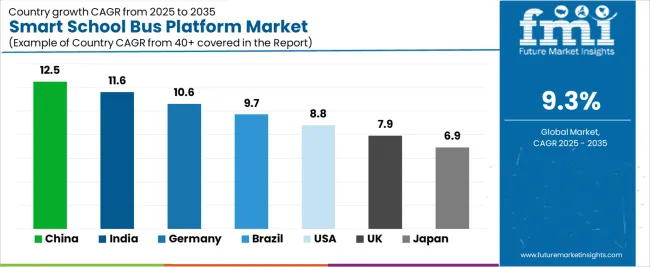
| Country | CAGR (2025 to 2035) |
|---|---|
| China | 12.5% |
| India | 11.6% |
| Germany | 10.6% |
| Brazil | 9.7% |
| United States | 8.8% |
| United Kingdom | 7.9% |
| Japan | 6.9% |
The smart school bus platform market is experiencing solid growth globally, with China leading at a 12.5% CAGR through 2035, driven by massive education infrastructure digitization, expanding urban school transportation networks, and government smart city initiatives promoting intelligent transportation adoption. India follows at 11.6%, supported by growing organized school transportation sector, increasing smartphone penetration enabling parent app adoption, and rising middle-class demand for student safety solutions.
Germany shows growth at 10.6%, emphasizing advanced vehicle connectivity, strict student safety regulations, and comprehensive data protection compliance frameworks. Brazil demonstrates 9.7% growth, supported by expanding private education sector, growing urbanization driving school bus adoption, and increasing investment in education infrastructure. The United States records 8.8%, focusing on regulatory compliance requirements, liability risk mitigation, and growing adoption of integrated fleet management solutions.
The United Kingdom exhibits 7.9% growth, emphasizing data privacy compliance and transportation contractor technology adoption. Japan shows 6.9% growth, supported by aging population driving automation adoption and precision safety monitoring requirements.
The report covers an in-depth analysis of 40+ countries, with top-performing countries highlighted below.

Revenue from smart school bus platforms in China is projected to exhibit exceptional growth with a CAGR of 12.5% through 2035, driven by expanding education infrastructure digitization and rapidly growing urban school transportation networks supported by government smart city initiatives and student safety regulation enforcement programs. The country's massive education sector modernization and increasing investment in intelligent transportation technologies are creating substantial demand for smart platform solutions. Major technology providers and transportation service companies are establishing comprehensive platform development capabilities to serve both urban school districts and expanding suburban education markets.
Demand for smart school bus platforms in India is expanding at a CAGR of 11.6%, supported by the country's growing organized school transportation sector, expanding smartphone penetration enabling parent application adoption, and increasing middle-class demand for student safety monitoring solutions. The country's comprehensive education sector expansion and technology adoption are driving sophisticated platform capabilities throughout diverse school segments. Leading transportation contractors and technology companies are establishing extensive service operations to address growing demand from private schools and international education institutions.
Revenue from smart school bus platforms in Germany is growing at a CAGR of 10.6%, supported by the country's leadership in vehicle connectivity technologies, strict student transportation safety regulations, and comprehensive data protection compliance requirements under GDPR frameworks. The nation's advanced automotive technology infrastructure and emphasis on safety are driving sophisticated platform capabilities throughout education transportation sectors. Leading technology providers and transportation companies are investing extensively in platform development and compliance certification.
Demand for smart school bus platforms in Brazil is expected to expand at a CAGR of 9.7%, supported by the country's expanding private education sector, growing urbanization driving school transportation adoption, and increasing investment in education infrastructure and safety compliance. The nation's education sector growth and urban development are driving demand for sophisticated monitoring solutions. Private schools and transportation service providers are investing in platform technology adoption to serve both domestic requirements and competitive differentiation objectives.
Revenue from smart school bus platforms in the United States is projected to grow at a CAGR of 8.8%, supported by the country's focus on transportation safety compliance, established school district operations, and growing emphasis on liability risk mitigation through comprehensive documentation and monitoring capabilities. The nation's mature education transportation infrastructure and legal liability concerns are driving demand for sophisticated platform solutions. School districts and transportation contractors are investing in technology upgrades and integrated fleet management capabilities to serve both regulatory and operational requirements.
Demand for smart school bus platforms in the United Kingdom is expanding at a CAGR of 7.9%, driven by the country's data privacy compliance frameworks, contracted school transportation model, and growing emphasis on safeguarding requirements and student welfare monitoring. The United Kingdom's regulatory environment and transportation sector structure are driving demand for compliant platform solutions. Transportation contractors and local education authorities are establishing comprehensive technology adoption programs for enhanced student safety monitoring.
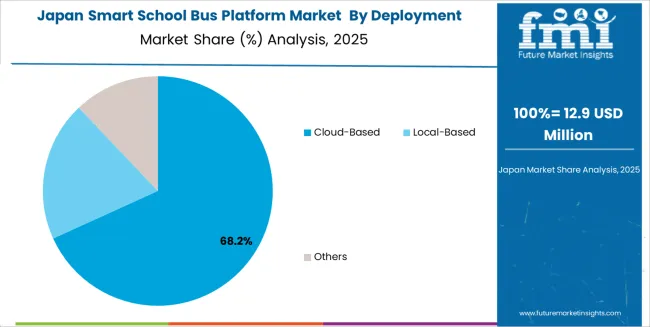
Revenue from smart school bus platforms in Japan is growing at a CAGR of 6.9%, supported by the country's technological sophistication, aging driver population driving automation interest, and strong emphasis on precision safety monitoring and incident prevention capabilities. Japan's technology leadership and safety culture are driving demand for advanced platform products. Education institutions and transportation companies are investing in specialized capabilities for comprehensive student safety applications.

The smart school bus platform market in Europe is projected to grow from USD 147.5 million in 2025 to USD 343.1 million by 2035, registering a CAGR of 8.8% over the forecast period. Germany is expected to maintain leadership with a 28.4% market share in 2025, moderating to 27.9% by 2035, supported by vehicle connectivity leadership, strict safety regulations, and comprehensive data protection frameworks.
The United Kingdom follows with 19.2% in 2025, projected at 18.8% by 2035, driven by contracted transportation model, safeguarding compliance requirements, and transportation service professionalization. France holds 16.7% in 2025, reaching 17.1% by 2035 on the back of education sector digitization and student safety initiatives. Italy commands 13.3% in 2025, rising slightly to 13.6% by 2035, while Spain accounts for 9.8% in 2025, reaching 10.2% by 2035 aided by private school growth and urban transportation expansion.
The Netherlands maintains 5.1% in 2025, up to 5.3% by 2035 due to smart mobility initiatives and technology adoption rates. The Rest of Europe region, including Nordic countries, Central & Eastern Europe, and other markets, is anticipated to hold 7.5% in 2025 and 7.1% by 2035, reflecting steady adoption in education transportation modernization and safety compliance programs.
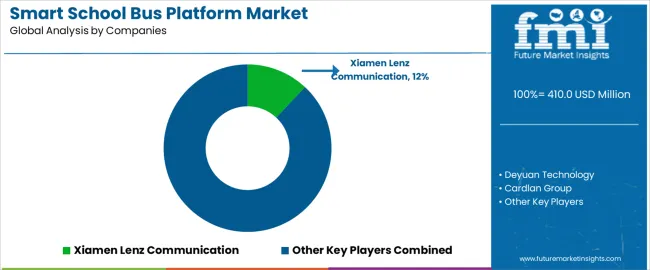
The smart school bus platform market is characterized by competition among established technology providers, specialized transportation management companies, and regional platform developers. Companies are investing in artificial intelligence integration, cloud platform development, mobile application enhancement, and video surveillance capabilities to deliver comprehensive, user-friendly, and cost-effective student transportation solutions. Innovation in predictive analytics, driver monitoring technologies, and multi-stakeholder communication features is central to strengthening market position and competitive advantage.
Xiamen Lenz Communication leads with comprehensive GPS tracking and communication platform solutions focused on student safety monitoring, real-time location services, and parent notification capabilities across school transportation applications. Deyuan Technology provides intelligent transportation platforms with emphasis on fleet management integration and operational efficiency optimization. Cardlan Group offers smart card and identification systems with platform connectivity for student attendance tracking and access control. Shandong Cvicse Middleware delivers enterprise platform solutions with focus on data integration and system interoperability.
Shenzhen Emperor Technology specializes in vehicle monitoring systems and IoT connectivity solutions for transportation safety applications. Hqshuke Group provides comprehensive education technology platforms including student transportation management modules. Suzhou Huaqi Intelligent Technology offers intelligent vehicle systems with monitoring and communication capabilities. Xiamen GNSS Development focuses on positioning technology and tracking solutions for fleet applications. SenseTime provides artificial intelligence capabilities for video analysis and driver monitoring.
Cloudwalk Technology specializes in facial recognition and biometric identification systems. Shenyang Xiasun offers vehicle safety monitoring equipment. Zhengjiang Hirige provides intelligent transportation solutions. Huawei delivers cloud infrastructure and connectivity platforms supporting smart transportation applications. Traffipax focuses on traffic safety and monitoring technology serving education sector requirements.
Smart school bus platforms represent a specialized technology segment within education transportation infrastructure, projected to grow from USD 410.0 million in 2025 to USD 997.6 million by 2035 at a 9.3% CAGR. These digital monitoring systems-primarily cloud-based and local-based configurations for multiple applications-serve as critical safety infrastructure in K12 education, special education facilities, and student transportation operations where enhanced tracking capabilities, real-time communication, and comprehensive safety monitoring are essential.
Market expansion is driven by increasing student safety regulations, growing parent engagement expectations, expanding IoT connectivity infrastructure, and rising demand for data-driven transportation management across diverse education institutions and contracted transportation services.
| Items | Values |
|---|---|
| Quantitative Units (2025) | USD 410.0 million |
| Deployment Model | Cloud-Based, Local-Based, Others |
| Application | K12 Schools, Special Education, Others |
| Regions Covered | East Asia, Europe, North America, South Asia, Latin America, Middle East & Africa, Eastern Europe |
| Countries Covered | China, India, Germany, Brazil, United States, United Kingdom, Japan, and 40+ countries |
| Key Companies Profiled | Xiamen Lenz Communication, Deyuan Technology, Cardlan Group, Shandong Cvicse Middleware, Shenzhen Emperor Technology |
| Additional Attributes | Dollar sales by deployment model and application category, regional demand trends, competitive landscape, technological advancements in platform development, artificial intelligence integration, mobile application innovation, and student safety optimization |
The global smart school bus platform market is estimated to be valued at USD 410.0 million in 2025.
The market size for the smart school bus platform market is projected to reach USD 997.7 million by 2035.
The smart school bus platform market is expected to grow at a 9.3% CAGR between 2025 and 2035.
The key product types in smart school bus platform market are cloud-based, local-based and others.
In terms of application, k12 schools segment to command 75.0% share in the smart school bus platform market in 2025.






Our Research Products

The "Full Research Suite" delivers actionable market intel, deep dives on markets or technologies, so clients act faster, cut risk, and unlock growth.

The Leaderboard benchmarks and ranks top vendors, classifying them as Established Leaders, Leading Challengers, or Disruptors & Challengers.

Locates where complements amplify value and substitutes erode it, forecasting net impact by horizon

We deliver granular, decision-grade intel: market sizing, 5-year forecasts, pricing, adoption, usage, revenue, and operational KPIs—plus competitor tracking, regulation, and value chains—across 60 countries broadly.

Spot the shifts before they hit your P&L. We track inflection points, adoption curves, pricing moves, and ecosystem plays to show where demand is heading, why it is changing, and what to do next across high-growth markets and disruptive tech

Real-time reads of user behavior. We track shifting priorities, perceptions of today’s and next-gen services, and provider experience, then pace how fast tech moves from trial to adoption, blending buyer, consumer, and channel inputs with social signals (#WhySwitch, #UX).

Partner with our analyst team to build a custom report designed around your business priorities. From analysing market trends to assessing competitors or crafting bespoke datasets, we tailor insights to your needs.
Supplier Intelligence
Discovery & Profiling
Capacity & Footprint
Performance & Risk
Compliance & Governance
Commercial Readiness
Who Supplies Whom
Scorecards & Shortlists
Playbooks & Docs
Category Intelligence
Definition & Scope
Demand & Use Cases
Cost Drivers
Market Structure
Supply Chain Map
Trade & Policy
Operating Norms
Deliverables
Buyer Intelligence
Account Basics
Spend & Scope
Procurement Model
Vendor Requirements
Terms & Policies
Entry Strategy
Pain Points & Triggers
Outputs
Pricing Analysis
Benchmarks
Trends
Should-Cost
Indexation
Landed Cost
Commercial Terms
Deliverables
Brand Analysis
Positioning & Value Prop
Share & Presence
Customer Evidence
Go-to-Market
Digital & Reputation
Compliance & Trust
KPIs & Gaps
Outputs
Full Research Suite comprises of:
Market outlook & trends analysis
Interviews & case studies
Strategic recommendations
Vendor profiles & capabilities analysis
5-year forecasts
8 regions and 60+ country-level data splits
Market segment data splits
12 months of continuous data updates
DELIVERED AS:
PDF EXCEL ONLINE
Smart Home Wireless Smoke Detector Market Size and Share Forecast Outlook 2025 to 2035
Smart Vision Processing Chips Market Size and Share Forecast Outlook 2025 to 2035
Smart Touch Screen Scale Market Size and Share Forecast Outlook 2025 to 2035
Smart Magnetic Drive Conveyor System Market Size and Share Forecast Outlook 2025 to 2035
Smart Wheelchair market Size and Share Forecast Outlook 2025 to 2035
Smart Mining Technologies Market Size and Share Forecast Outlook 2025 to 2035
Smart Parking Market Size and Share Forecast Outlook 2025 to 2035
Smart Digital Valve Positioner Market Forecast and Outlook 2025 to 2035
Smart Card IC Market Size and Share Forecast Outlook 2025 to 2035
Smart-Tag Inlay Inserters Market Analysis - Size and Share Forecast Outlook 2025 to 2035
Smart TV Market Forecast and Outlook 2025 to 2035
Smart/AI Toy Market Size and Share Forecast Outlook 2025 to 2035
Smart Locks Market Size and Share Forecast Outlook 2025 to 2035
Smart Sprinkler Controller Market Size and Share Forecast Outlook 2025 to 2035
Smart Indoor Gardening System Market Size and Share Forecast Outlook 2025 to 2035
Smart Building Delivery Robot Market Size and Share Forecast Outlook 2025 to 2035
Smart Watch Market Size and Share Forecast Outlook 2025 to 2035
Smart Label Market Size and Share Forecast Outlook 2025 to 2035
Smart Mat Market Size and Share Forecast Outlook 2025 to 2035
Smart Water Management Market Size and Share Forecast Outlook 2025 to 2035

Thank you!
You will receive an email from our Business Development Manager. Please be sure to check your SPAM/JUNK folder too.
Chat With
MaRIA